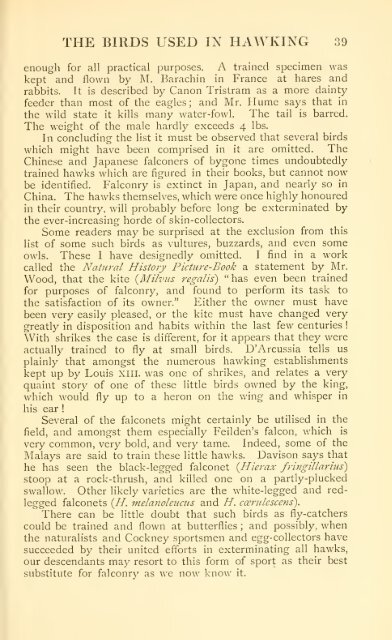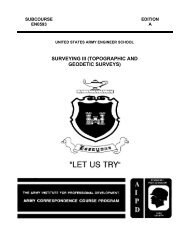The art and practice of hawking - Modern Prepper
The art and practice of hawking - Modern Prepper
The art and practice of hawking - Modern Prepper
- No tags were found...
Create successful ePaper yourself
Turn your PDF publications into a flip-book with our unique Google optimized e-Paper software.
THE BIRDS USED IN HAAYKING 39<br />
enough for all practical purposes. A trained specimen was<br />
kept <strong>and</strong> flown by M. Barachin in France at hares <strong>and</strong><br />
rabbits. It is described by Canon Tristram as a more dainty<br />
feeder than most <strong>of</strong> the eagles ; <strong>and</strong> Mr. Hume says that in<br />
the wild state it kills many water-fowl. <strong>The</strong> tail is barred.<br />
<strong>The</strong> weight <strong>of</strong> the male hardly exceeds 4 lbs.<br />
In concluding the list it must be observed that several birds<br />
which might have been comprised in it are omitted. <strong>The</strong><br />
Chinese <strong>and</strong> Japanese falconers <strong>of</strong> bygone times undoubtedly<br />
trained hawks which are figured in their books, but cannot now<br />
be identified. Falconry is extinct in Japan, <strong>and</strong> nearly so in<br />
China. <strong>The</strong> hawks themselves, which were once highly honoured<br />
in their country, will probably before long be exterminated by<br />
the ever-increasing horde <strong>of</strong> skin-collectors.<br />
Some readers may be surprised at the exclusion from this<br />
list <strong>of</strong> some such birds as vultures, buzzards, <strong>and</strong> even some<br />
owls. <strong>The</strong>se I have designedly omitted. I find in a work<br />
called the Natural History Pictm^e-Book a statement by Mr.<br />
Wood, that the kite {Mihncs regalis) "has even been trained<br />
for purposes <strong>of</strong> falconry, <strong>and</strong> found to perform its task to<br />
the satisfaction <strong>of</strong> its owner." Either the owner must have<br />
been very easily pleased, or the kite must have changed very<br />
greatly in disposition <strong>and</strong> habits within the last few centuries !<br />
With shrikes the case is different, for it appears that they were<br />
actually trained to fly at small birds. D'Arcussia tells us<br />
plainly that amongst the numerous <strong>hawking</strong> establishments<br />
kept up by Louis XIII. was one <strong>of</strong> shrikes, <strong>and</strong> relates a very<br />
quaint story <strong>of</strong> one <strong>of</strong> these little birds owned by the king,<br />
which would fly up to a heron on the wing <strong>and</strong> whisper in<br />
his ear !<br />
Several <strong>of</strong> the falconets might certainly be utilised in the<br />
field, <strong>and</strong> amongst them especially Feilden's falcon, which is<br />
very common, very bold, <strong>and</strong> very tame. Indeed, some <strong>of</strong> the<br />
Malays are said to train these little hawks. Davison says that<br />
he has seen the black-legged falconet {Hierax fringillarius)<br />
stoop at a rock-thrush, <strong>and</strong> killed one on a p<strong>art</strong>ly-plucked<br />
swallow. Other likely varieties are the white-legged <strong>and</strong> redlegged<br />
falconets (//. melanoleums <strong>and</strong> H. ca^ridescens).<br />
<strong>The</strong>re can be little doubt that such birds as fly-catchers<br />
could be trained <strong>and</strong> flown at butterflies ; <strong>and</strong> possibly, when<br />
the naturalists <strong>and</strong> Cockney sportsmen <strong>and</strong> egg-collectors have<br />
succeeded by their united efforts in exterminating all hawks,<br />
our descendants may resort to this form <strong>of</strong> sport as their best<br />
substitute for falconry as we now know it.

















